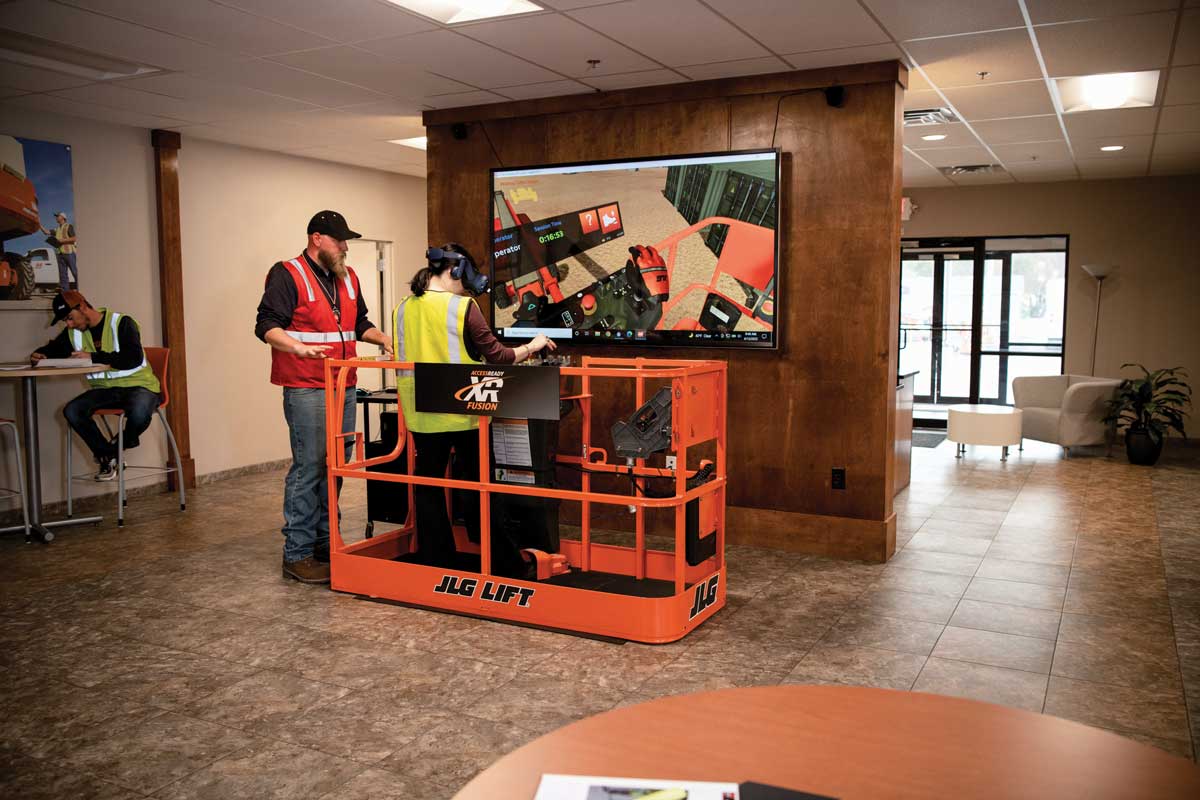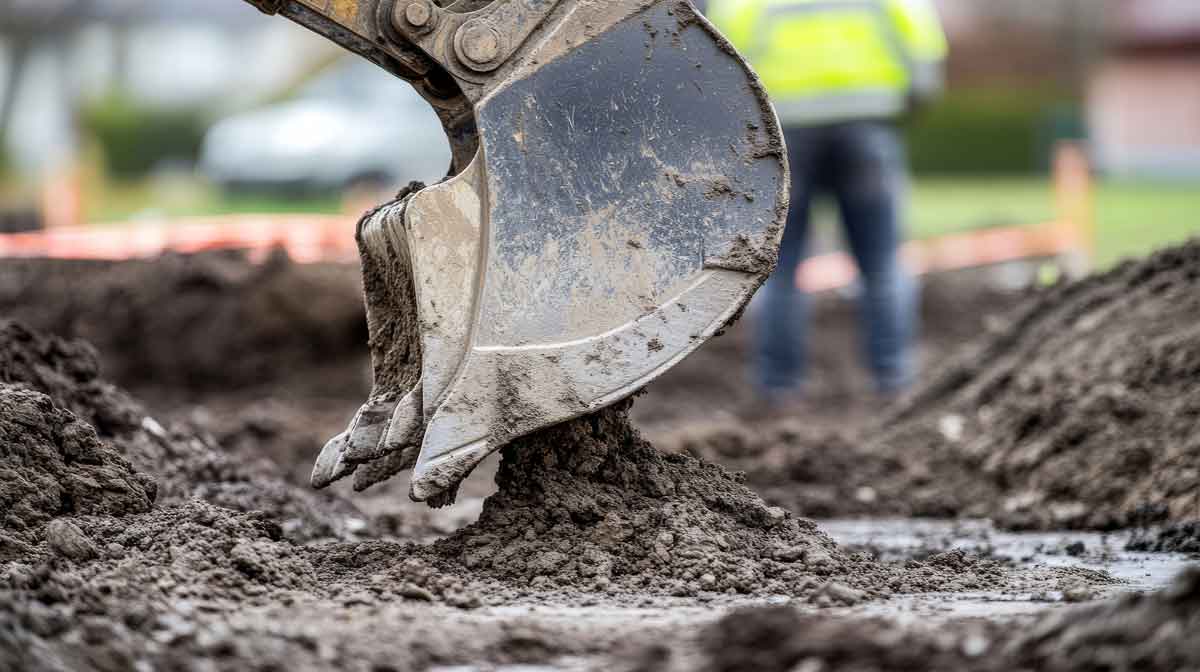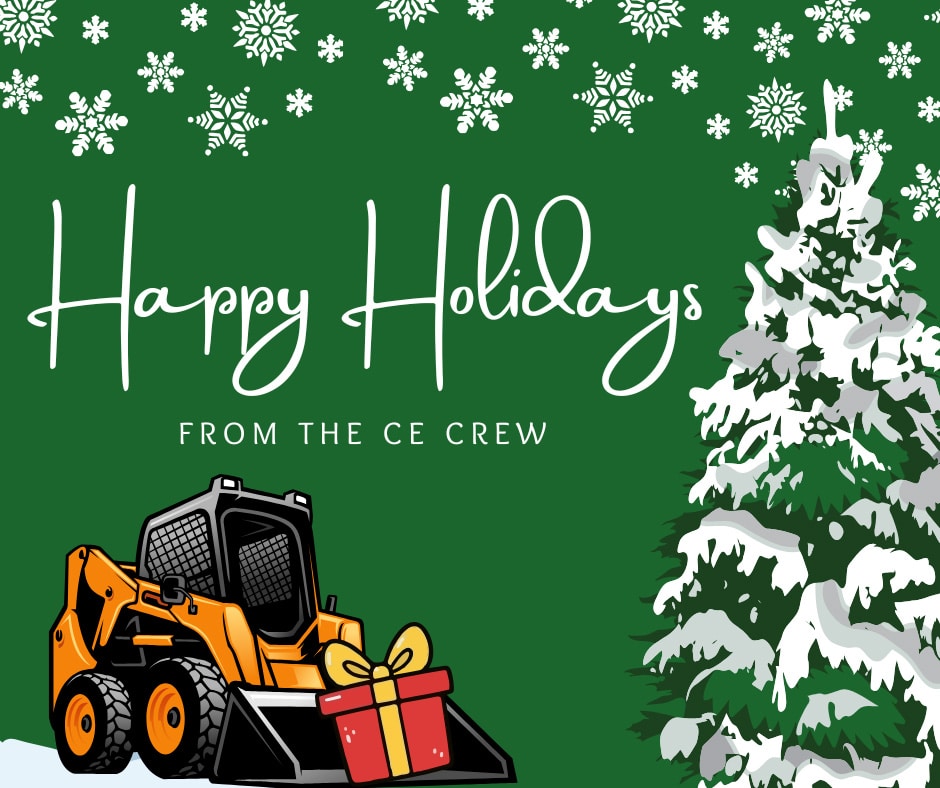Cat Command: Operating Caterpillar’s Non-Line-of-Sight Remote-Control System in Our Office Parking Lot
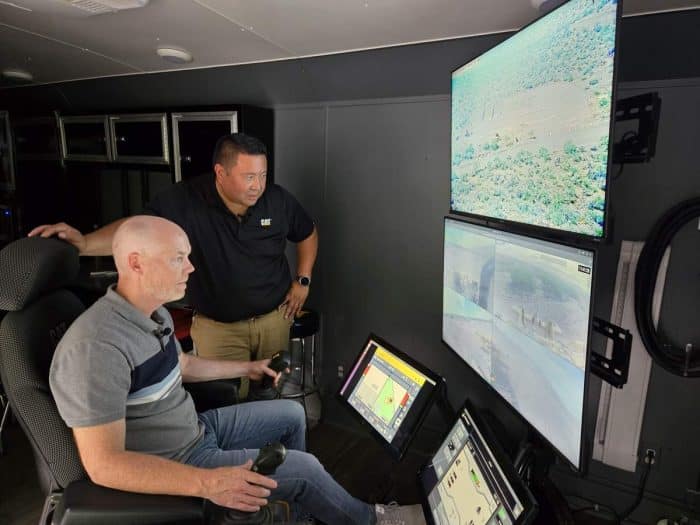
Typically, our Editor at Large column involves an editor or publisher getting out of the office, traveling somewhere in the United States and operating equipment — while auditing the production facilities where these machines are made. Finally, in this edition, the machines came to us.
A boring Tuesday in the office recently turned into an awesome day of operation when the Cat Command trailer pulled up into our Richfield, Ohio, parking lot (between Cleveland and Akron). Command is an umbrella brand that includes Caterpillar’s autonomous, semi-autonomous and remote-control systems. The Cat Command trailer specifically showcases Cat’s impressive non-line-of-sight remote-control services — housed within a portable office. Caterpillar marketing professional Alan Pumklin drove the Cat Command trailer to our Ohio offices, allowing me to operate three different machines — an excavator, dozer and wheel loader — from northeast Ohio, controlling units remotely in North Carolina and Arizona.
“A lot of folks have probably seen this same trailer,” said Pumklin, showing me around the mobile remote-control station. “This particular trailer has been across the country countless times, and we take it to jobsites as well. We’re here in Cleveland in your parking lot, and we’re able to let you stay home, go to your normal office and come out here and operate machines. Today, we’re going to be running machines in Clayton, North Carolina, and Tucson, Arizona. So, East Coast, West Coast, a three-hour difference in time zones.”

From a safe distance and with the help of automated precision — using machine control systems like Cat Grade — I had the awesome opportunity to manipulate an excavator, dozer and wheel loader, in one case from nearly 2,000 miles away. The setup resembled a high-tech gaming station, but this day was not just about pushing buttons. It was about pushing boundaries. Before we get into my personal experience, let’s look at the many products under the Cat Command portfolio.
Commanding Performance

Cat Command remote control and autonomy solutions are popular for machine applications that involve hazardous materials or unsafe conditions. Imagine dozers brought in to shift and compact the waste from coal-fired power plants, which pose a hazard for workers. Picture a skid steer removing spillage from under overhead conveyors carrying aggregate that might harm people trying to do the same job. Remote control, semi autonomy and autonomy can take operators off the machine and away from dangers, but it’s not just about safety. Productivity, fuel consumption and fleet optimization can all be streamlined using a system like Cat Command, which often gets paired with a variety of other automation technologies like grade control for dozers or payload telemetry for wheel loaders.
“For example, we’ve been using Command in mining and power plants for a while now — purely from a safety perspective — hazardous site remediation,” explains Pumklin. “So anytime that there’s going to be potential risk of human life or injury to humans it makes sense, but we’re seeing a lot more customers use it for efficiency. For example, we have stevedoring customers that will run Command machines in the bottom of the ship hold to consolidate material, and they’ll cover 50 miles of river without ever transporting their operators. Same thing with agriculture. Imagine all the grain that’s moved through our river systems in the U.S. A lot of it’s removed from those barges via Cat Command.”

With Command technologies, Caterpillar talks about eliminating the “3 Ds” — dull, dirty and dangerous jobs — which can offer cascading benefits even beyond safety and increased production. Greater operator comfort and safety results in potentially easier recruitment and employee retention. It enables operators to run equipment where site issues (such as having to climb stairs or work in dusty environments) might aggravate past injuries or ongoing heath conditions. It prolongs operator careers by helping to prevent long-term debilitation from noise, heavy vibration and dirty conditions.
The top echelon of Cat Command is autonomy, which we’ve seen mostly in the mining sector. Cat’s automation suite, Cat MineStar Command, fully integrates operation of autonomous, semi-autonomous and remotely controlled mining machines and systems. Cat MineStar Command solutions make it possible for miners to automate a single mining process, remotely control a single machine, automate multiple types of equipment across a mixed fleet or implement a completely autonomous fleet of haul trucks that operate around the clock with no human intervention.
“We have fully autonomous mining trucks under Cat Command,” confirms Pumklin, noting there are about 600 autonomous Cat mining trucks operating in the field today. “There’s also semi-autonomous, when we automate a lot of the work cycles of a machine. Now that operator can have multiple machines, right? We’re doing that in mining with D11 dozers. A single operator can manage up to five dozers that are running autonomous work cycles. The only time they need to intervene is when an exception happens. Let’s say a dozer hits a rock that was unexpected, and it needs to be dug out manually.”
Semi-autonomy has been utilized on compact equipment, although in prototype applications. Back in 2022, Cat showcased its Cat 299D3 compact track loader with both remote control and semiautonomous capabilities. The 299D3 was working on a solar farm, moving solar panels and other installation gear over acres of utility farm. From outside the cab, the worker would remotely control the unit, lift a pallet and then use a tablet to tell the track loader where to go. The CTL would then autonomously drive, avoiding obstacles, and deliver its drop-off sequence and return. A blue light shining on the cab showed it was running in unstaffed mode, with no one inside.
“Then, of course, there’s just remote control,” says Pumklin. “That’s the very popular offering that we’re going to show you today, which is our non-line-of-sight offering. We also offer line of sight, which means just like it says, you’re operating a machine with line of sight to it with a remote control. We call that an over-the-shoulder console.”
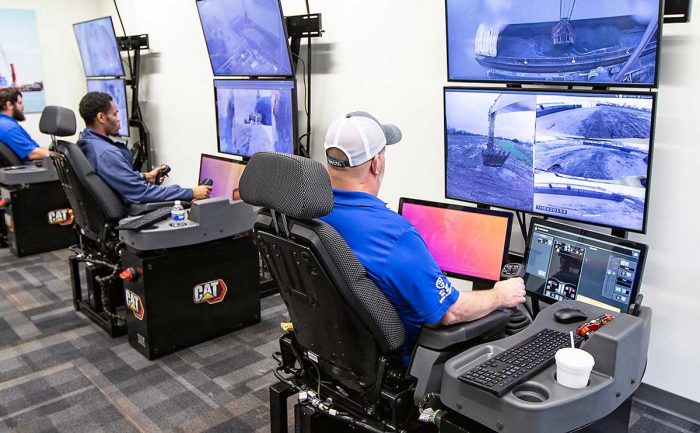
Cat Command Console is the company’s line-of-sight (LOS) system, and it involves a small, portable control box with joysticks, knobs, joysticks, switches, buttons and a little screen showing machine vitals. It provides control over a single machine, running a track loader, wheel loader or excavator from up to 1,300 ft away with precise control. Command Console provides a relatively affordable way to get started in the world of remote control, and the system needs no site communications infrastructure.
Non-line-of-sight (NLOS) systems — such as the Cat Command Station — let the operator work from many miles away in a virtual cab environment. The simulated cab includes a range of video feeds, a comfortable seat and full complement of realistic-feeling hand and foot controls. Operators can work from an indoor, office-like environment close to home, without commuting to distant jobsites. They can also switch to a different machine or even a different jobsite instantly with the push of a button.
Compact track loaders are the most popular category of compact equipment in America. Learn why with loads of track loader features right here.
From the Desk to the Dozer
I was lucky enough to switch between three different machines using a Cat Command station outside of CE offices this July. The Cat Command trailer opens from the side, revealing the Command Station, which looks like the ultimate gaming setup. The remote operating station can use three to five televisions showing cameras from inside the cab, front, back and sides and a long-distance view of the unit. The station can be configured to a customer’s exact application — TVs, pedals, joysticks, switches, etc.
The rest of the Cat Command trailer is fitted with a fridge, microwave, cabinets, stools and table for lunch and relaxing. Watch our Machine Heads video above. The air conditioning, lighting and quietness of the trailer and operating offsite makes operation ultra comfortable, but it is definitely different. You lose that seat of your pants feel and the vibration of a machine — especially on smaller machines — where feeling the machine helps operators understand when a unit is working optimally. Of course, once you stick all those cameras on a machine, operators almost have a better vision of what’s going on around them.
“As our many customers around the world adapt to running this type of operation, they become adept at scanning the different screens,” says Pumklin. “You have four machine cameras, and then you have your dashboard. It becomes just natural to scan those as you operate, and then the muscle memory will come along with it.”
First, I operated a 340 excavator, which was working at Caterpillar’s Tinaja Hills Demonstration and Learning Center in Arizona. I dug a V-ditch using 3D grade control to get millimeter accuracy. Pumklin put the excavator in backhoe pattern because I’m an old fogey. “It’s very customizable,” he noted. “We want to make sure that you’re comfortable with how it’s configured and set up.”
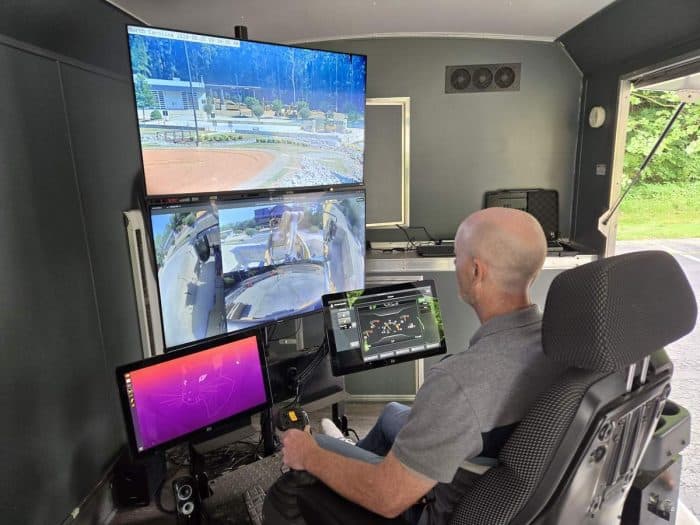
With the push of a button, I jumped to operating a 938M Series wheel loader at the Rapp Customer and Training Center in Clayton, North Carolina. I was moving gravel, utilizing the optimized Z-bar loader linkage on the 938M, while capitalizing on technologies like return to dig and automatic bucket kick-outs. Through the Cat Command module, I was able to create digital lines on the screen as reference points to easily load and dump precisely. “This dotted line here is a reference line to help you with perception,” says Pumklin. “In this case, we set it up so when you go up to, let’s say the truck bed, you are going to line that line — this virtual line — up with the top of the [truck bed] to help with dumping.”
Next, I switched back to Tinaja Hills to operate a D5 dozer, cleaning up the V-ditch I created earlier with the excavator. I utilized excellent assist features like auto carry, “where remotely you’re able to get a full blade load and then the machine will maintain that blade load for you,” explains Pumklin. “It takes a burden off the operator. That’s one less thing you have to worry about while you’re running remotely.”
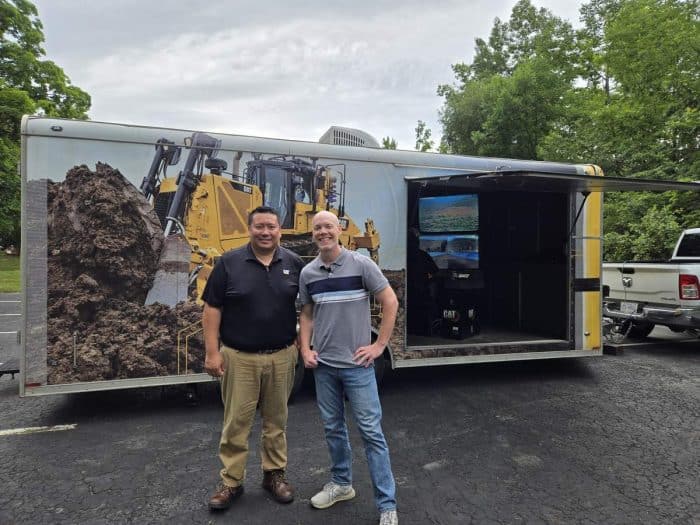
It took a while, but by the end of our demo, I felt semi-confident operating machines remotely from a different state. It takes practice, but its advantages are obvious. Luckily, with autos like grade control and auto carry, novice operators can seem like pros in a short amount of time and training. These technologies integrate very well into the whole formula of Cat Command — remote control to grade control — and the experience gave me a better appreciation of how tech is rapidly evolving the industry.
“I remember when I was younger, playing with remote controlled cars. That’s the first thing I did,” muses Pumklin. “Now I kind of laugh. Now I have remote control for Caterpillar machines. But when you realize you can do real work with it and be proficient, you realize it’s not a toy. You realize you can change the way you work.”
Keith Gribbins is publisher of Compact Equipment.
Cat Command for Compact Equipment
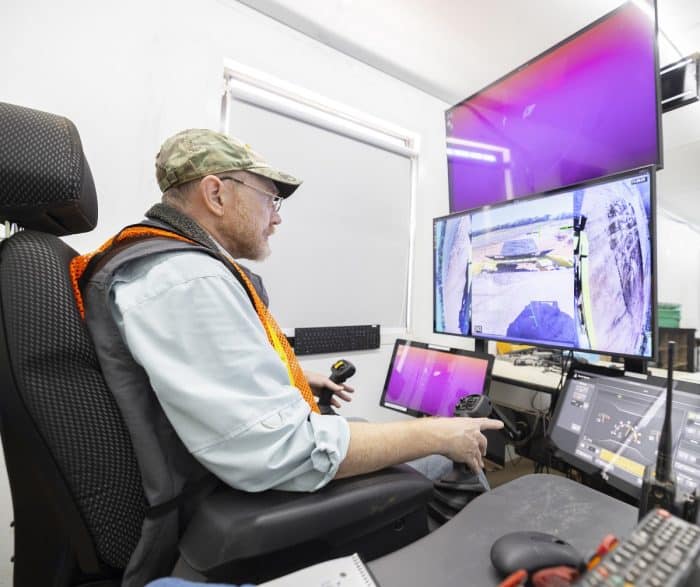
Back in 2022, Cat won an Innovative Iron Award for its expansion of Cat Command for Loading to its D3-Series skid steers and track loaders. A dealer-installed field kit can make any Cat D3 skid steer or compact track loader model Command-ready, allowing it to be operated comfortably from a safe location when the machine is working in hazardous environments like stevedoring, steel mill blast furnaces, industrial and waste, demolition and site decommissioning. Cat Command for Loading for skid steers and compact track loaders are available in two configurations — line-of-sight at the jobsite and non-line-of-sight operating via a cool remote station.
“Our D3 compact track loaders and skid steers are all capable of line of sight and none line sight, and those are some of our most popular models,” says Alan Pumklin, Caterpillar marketing professional. “Probably in 2017 or so, we started to bring this technology down to construction-sized equipment. In regard to compact equipment, when we talk about our mini excavators we have line of sight for all of our mini excavators. As soon as you get to about a 313 and all the way up to a 395 excavator, you have line of sight and non line of sight. That’s a tremendous amount of machines. We go back all the way to our Next Gen, so what, seven, eight years? About eight years of population for our excavators that can be retrofitted with this.”
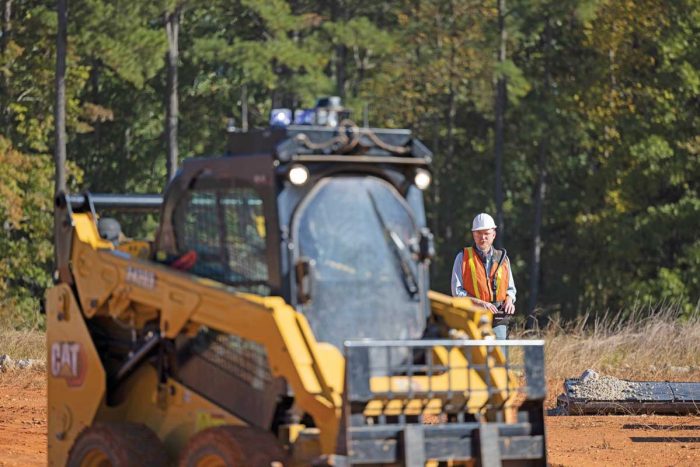
The line-of-sight (LOS) system includes indicator lights, microphone, wireless receiver and antennas with front, rear and side cameras for 360-degree viewing, all installed on the cabin roof. A command activation switch is mounted behind a lockable door with ground-level access. Two different LOS consoles will be available to meet customer needs, each providing different levels of functionality and control with complex hydromechanical attachments.
The non-line-of-sight (NLOS) Cat Command solution includes a modular, customized Command station that positions users in a familiar and comfortable seated position that simulates traditional machine control. Station components include machine joystick and foot pedal controls for all the company’s Command technology capable machines. A touchscreen mount is incorporated in the station design for machine control, while universal screen mounts are included for camera display. An emergency remote shutdown switch is located on the Command station to quickly halt all machine movements. At the jobsite, an optional remote all-stop switch control is available for site personnel working around non-line-of-sight Command machines. The Command station is compatible for Cat equipment from skid steers and excavators to dozers and small wheel loaders.

